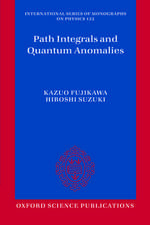The Physics of Music and Color: Sound and Light
Autor Leon Guntheren Limba Engleză Paperback – 4 noi 2020
A novel topic in the first edition and this second edition is a non-mathematical study of electric and magnetic fields and how they provide the basis for the propagation of electromagnetic waves, of light in particular. The book provides details for the calculation of color coordinates and luminosity from the spectral intensity of a beam of light as well as the relationship between these coordinates and the color coordinates of a color monitor.
The second edition contains corrections to the first edition, the addition of more than ten new topics, new color figures, as well as more than forty new sample problems and end-of-chapter problems. The most notable additional topics are: the identification of two distinct spectral intensities and how they are related, beats in the sound from a Tibetan bell, AM and FM radio, the spectrogram, the short-time Fourier transform and its relation to the perception of a changing pitch, a detailed analysis of the transmittance of polarized light by a Polaroid sheet, brightness and luminosity, and the mysterious behavior of the photon.
The Physics of Music and Color is written at a level suitable for college students without any scientific background, requiring only simple algebra and a passing familiarity with trigonometry. The numerous problems at the end of each chapter help the reader to fully grasp the subject.
| Toate formatele și edițiile | Preț | Express |
|---|---|---|
| Paperback (2) | 506.63 lei 6-8 săpt. | |
| Springer International Publishing – 4 noi 2020 | 506.63 lei 6-8 săpt. | |
| Springer – 8 dec 2014 | 709.91 lei 6-8 săpt. | |
| Hardback (1) | 569.48 lei 38-44 zile | |
| Springer International Publishing – 4 noi 2019 | 569.48 lei 38-44 zile |
Preț: 506.63 lei
Nou
Puncte Express: 760
Preț estimativ în valută:
96.94€ • 101.22$ • 80.05£
96.94€ • 101.22$ • 80.05£
Carte tipărită la comandă
Livrare economică 15-29 aprilie
Preluare comenzi: 021 569.72.76
Specificații
ISBN-13: 9783030192211
ISBN-10: 3030192210
Pagini: 475
Ilustrații: XXIII, 475 p. 492 illus., 205 illus. in color.
Dimensiuni: 178 x 254 mm
Greutate: 0.86 kg
Ediția:2nd ed. 2019
Editura: Springer International Publishing
Colecția Springer
Locul publicării:Cham, Switzerland
ISBN-10: 3030192210
Pagini: 475
Ilustrații: XXIII, 475 p. 492 illus., 205 illus. in color.
Dimensiuni: 178 x 254 mm
Greutate: 0.86 kg
Ediția:2nd ed. 2019
Editura: Springer International Publishing
Colecția Springer
Locul publicării:Cham, Switzerland
Cuprins
Chapter1: Introductory Remarks.- Chapter2: The Vibrating String.- Chapter3: The Nature of Sound; The Vibrating Air Column.- Chapter4: Energy.- Chapter5: Electricity & Magnetism.- Chapter6: The Atom as a Source of Light.- Chapter7: The Principle of Superposition.- Chapter 8: Complex Waves.- Chapter9: Propagation Phenomena.- Chapter10: The Ear.- Chapter11: Psychoacoustics.- Chapter12: Tuning, Intonation, and Temperament - Choosing Frequencies for Musical Notes.- Chapter13: The Eye.- Chapter14: Characterizing Light Sources, Color Filters, and Pigments.-Chapter15: Theory of Color Vision.- Appendices.
Notă biografică
Leon Gunther has been on the Physics Department faculty at Tufts University since 1965. He got his PhD in Physics from MIT in 1964 and has published over 100 articles, the vast majority being in the field of Condensed Matter Theory. Most notable were his papers on low-dimensional systems, which were the forerunner of Nanoscopic Physics. His seminal papers on the quantum behavior of nanoscopic magnets at low temperatures reflect current research in the development of computer hard drives having a higher capacity. Having begun studies of the violin at the age of seven, he has played in numerous Community Symphony Orchestras, most notably the Newton Symphony, is currently a member of the Wellesley Symphony Orchestra. In 1994, he founded the community chorus of Temple Emunah in Lexington, MA, known as the Mak'haylah. Programs include music of a wide range of genres - folk, liturgical, and classical. His compositions and arrangements include Hebrew renditions of three movements of the Brahms Requiem.
Textul de pe ultima copertă
This undergraduate textbook aids readers in studying music and color, which involve nearly the entire gamut of the fundamental laws of classical as well as atomic physics. The objective bases for these two subjects are, respectively, sound and light. Their corresponding underlying physical principles overlap greatly: Both music and color are manifestations of wave phenomena. As a result, commonalities exist as to the production, transmission, and detection of sound and light. Whereas traditional introductory physics textbooks are styled so that the basic principles are introduced first and are then applied, this book is based on a motivational approach: It introduces a subject with a set of related phenomena, challenging readers by calling for a physical basis for what is observed.
A novel topic in the first edition and this second edition is a non-mathematical study of electric and magnetic fields and how they provide the basis for the propagation of electromagnetic waves, of light in particular. The book provides details for the calculation of color coordinates and luminosity from the spectral intensity of a beam of light as well as the relationship between these coordinates and the color coordinates of a color monitor.
The second edition contains corrections to the first edition, the addition of more than ten new topics, new color figures, as well as more than forty new sample problems and end-of-chapter problems. The most notable additional topics are: the identification of two distinct spectral intensities and how they are related, beats in the sound from a Tibetan bell, AM and FM radio, the spectrogram, the short-time Fourier transform and its relation to the perception of a changing pitch, a detailed analysis of the transmittance of polarized light by a Polaroid sheet, brightness and luminosity, and the mysterious behavior of the photon.The Physics of Music and Color is written at a level suitable for college students without any scientific background, requiring only simple algebra and a passing familiarity with trigonometry. The numerous problems at the end of each chapter help the reader to fully grasp the subject.
A novel topic in the first edition and this second edition is a non-mathematical study of electric and magnetic fields and how they provide the basis for the propagation of electromagnetic waves, of light in particular. The book provides details for the calculation of color coordinates and luminosity from the spectral intensity of a beam of light as well as the relationship between these coordinates and the color coordinates of a color monitor.
The second edition contains corrections to the first edition, the addition of more than ten new topics, new color figures, as well as more than forty new sample problems and end-of-chapter problems. The most notable additional topics are: the identification of two distinct spectral intensities and how they are related, beats in the sound from a Tibetan bell, AM and FM radio, the spectrogram, the short-time Fourier transform and its relation to the perception of a changing pitch, a detailed analysis of the transmittance of polarized light by a Polaroid sheet, brightness and luminosity, and the mysterious behavior of the photon.The Physics of Music and Color is written at a level suitable for college students without any scientific background, requiring only simple algebra and a passing familiarity with trigonometry. The numerous problems at the end of each chapter help the reader to fully grasp the subject.
Caracteristici
Deals with related subjects of sound and light in one volume Requires no scientific background and little mathematical background Motivational approach to physics learning Teaches students how to respond to physical phenomena by searching for a deeper appreciation of what is observable New edition contains new topics in sections, subsections, and in end-of-chapter problem sets















